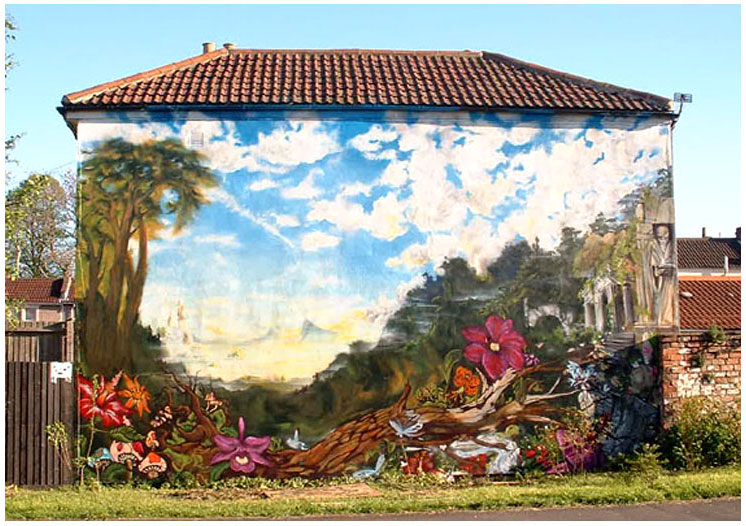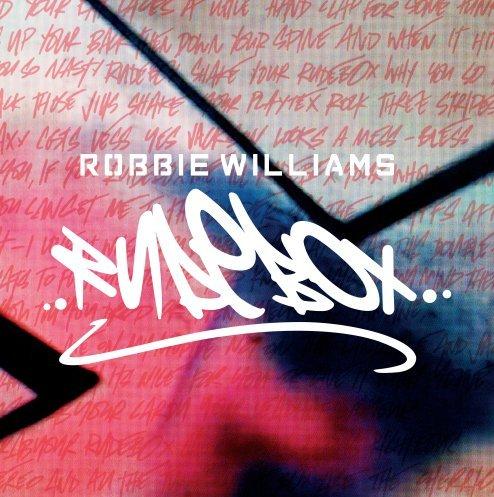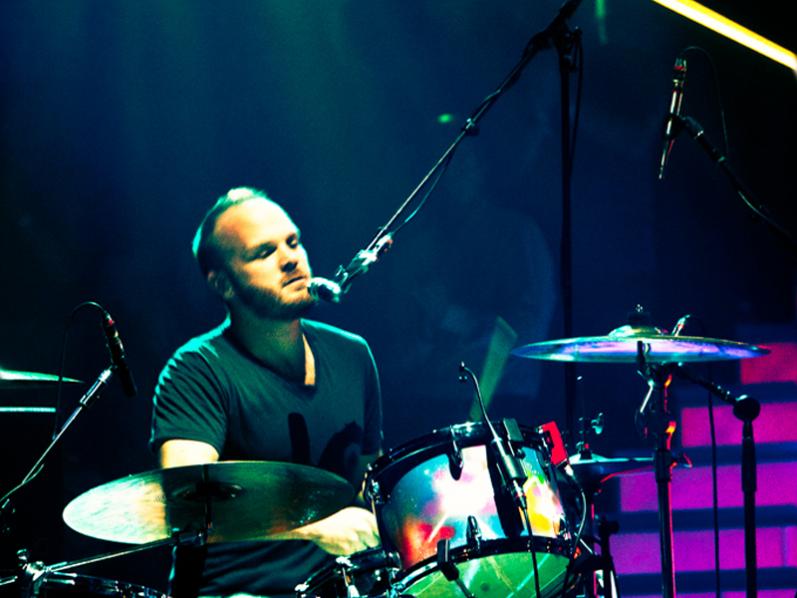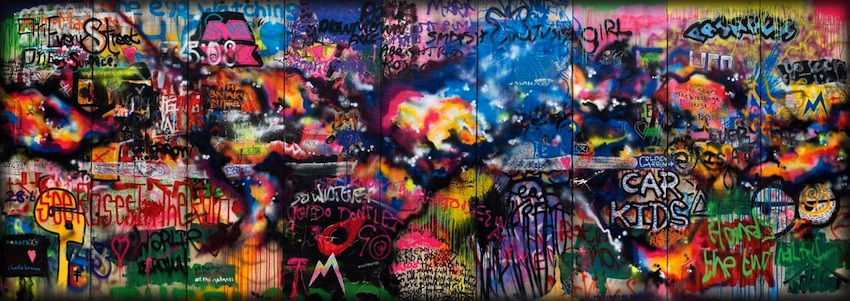
Interview: Paris, Coldplay’s artist in residence (pt 1)
Apr 01, 2012Hi Paris, how are you?
I’m really good thanks.
Let’s start at the beginning: how did you first get involved with Coldplay?
For the last few years I’ve been involved with decorating The Park area at Glastonbury Festival. Misty and Reg run that, and Misty’s been involved with Coldplay doing the sets for the shows and the Christmas Lights video. I think the band were putting out the word that they were looking for a graffiti artist. And I think [Glastonbury co-organiser] Emily Eavis actually recommended me first. I just got a phone call out the blue from Misty asking if I’d like to work with a band.
Paris. (Photo by Roadie #42)
She didn’t say which band?
No, I wasn’t told who they were. But then I turned up at the studio and saw some flightcases with Coldplay written on them. They’d been messing around with graffiti already. I realised that the day I turned up at the studio, when I saw that there was already a lot of it going on. But they hadn’t actually met a graffiti artist in person.
Are there any bands you would have said no to?
Haha, I don’t know! But the beauty of the whole Coldplay project was the ideas that they were bringing to it all. It was very different for me, but so refreshing as well. I’ll take on any job. But I was initially just brought in to give them a demonstration and show them how to do it.
Like a graffiti class?
Absolutely. You see graffiti and street art appear all over the place, but it’s quite rare when you can see people actually do it. So I was just explaining all about it, and I had my portfolio there, showing examples.

A real 20th Century Frescoe, by Xenz & Paris, Bristol 04
How did you learn how to do it?
Just as a kid growing up in the 80s in Hull. It wasn’t too easy to go and do oil painting or life drawing there! So me and my friends sort of taught ourselves. Hull had lots of derelict buildings then, so we used to just go there and practice in places where people wouldn’t really see it. We’d just have fun with it.
Did you go by the Paris name from an early age?
Fairly early. I messed about with a couple of other names. It’s like any pen name, the right one comes along at the right time. I went on a college trip to Paris and that opened my eyes to seeing graffiti on a big scale, with the passion and the flamboyance of the French style. That’s when I took that name and it stuck. Which was about 1992.
So it’s the 20th anniverary of Paris-ness this year?
It is! There’s something to celebrate!
What were you called before Paris?
Haha! I’d rather not say. It was a bit all over the place. And this was pre-internet so quite often you’d maybe pick up a magazine and see that someone else was using the same name. And you can’t really have that.
Did you have any brushes with the law in those early days?
Well, you do everything you can not to get any trouble. I don’t think I got in trouble in Hull, because they don’t really make a big deal of it there and we never went out of our way to cause offence. We’d paint in abandoned buildings and places that had been left to rot for years. Nobody would bother us and we wouldn’t bother anyone else.
And in Bristol?
I did get in a little bit of trouble there, but that was really just miscommunication. We painted a wall which we’d been told had been left for a mural, but that the mural never happened. So we painted it thinking it was OK to do it, but it turned out it was a local policeman’s mural, like his pet project. So we got nicked for that. But it never came to anything serious. Just a slap on the wrists and an apology.
Did you study art?
I did. I took the art route as soon as I could, pretty much from school. I did a BTEC and then an HND and then I came and studied fashion and textiles in Bristol. Which was just a really loose, free course. At that age, I had a sort of fear of fine art – which I think you have coming from somewhere like Hull.
Your parents are not bohemian, arty types then?
Haha! No, not in the slightest! They can’t even draw. My grandad did some water colours and I’ve got a relative who’s quite a famous marine artist. So it does run in the family a bit, but not with my parents.
Was graffiti always a part of what you did, even when you were studying fashion?
It’s definitely always informed my work, yeah. The use of materials and the way you look at the world, I think. Graffiti for me always has been a very loose and free form of expression. You can get used to working on a big scale and I think for me it was always about the medium. Spray paint’s very fast and vivid. And it was really good for making textile patterns and just for painting freely.
You have worked on other music business projects before, right? Didn’t you work on a Robbie Williams campaign?
Yes, that was in 2006, I think. For his Rudebox album. We did a lot of work and you didn’t really see that much of it in the finished thing. Rankin was photographing it and we were brought in to do this incredible set which was like a fake half of a subway train and they’d actually recreated part of the Westway flyover from London, just with wood and plaster. We painted all that and it was all photographed by Rankin. In the finished cut, you barely saw any of our work, but it was a great job to be part of.

When you say “our work”, do you work as a team?
I’m mainly solo these days, but my girlfriend, Milk, paints graffiti too. And when Coldplay have asked for really big jobs, they’ve often said, “Can you get some of your mates along”. So I’ll bring in a some of my tight group of friends. Like with the Teardrop video when we needed a lot of people to paint. But it’s mainly been me and Milk that have done the massive jobs for Coldplay.
So, how did you go from that initial visit to Coldplay’s studio to show them how it was done to being more involved?
It was really organic. I think they had a good time – everyone got involved – it was quite a big group. Misty was involved and I think even the artwork designers, Tappin Gofton, popped in for a bit. It was a really fun day. We did a bit of drawing and a bit of spraying and then it was only like a week later that they called me back again to do a bit more. It seemed like it was a fun thing for them to do, while they were recording the album.
They do seem to enjoy being creative in the studio.
Absolutely. And just to have fun. So I did some more and then Will asked me to do his drumkits and from that it really started to pick up speed. I’d get these lovely phone calls saying, “Would you mind getting involved with our album cover?” and that sort of thing.

Did any of the band members show a particular aptitude for graffiti when you were teaching them?
They really all did. Everyone took to it. On the very first session we were in the Bakery and it sort of came down to everyone just picking up spray cans and running around and drawing on stuff. I was showing them the right nozzles to use and the good colours. But I think they’d been doing their homework. There were a lot of graffiti books around and they had a lot of questions to ask. They were really well schooled. I was just joining the dots.
Was the album cover the first big official thing you worked on for Coldplay?
Yeah. And then once it picked up speed, things happened really, really fast. I did Will’s drumkits – one for the States and one for the UK. And then I was contacted by Tappin Gofton about the album cover. They’d been doing a lot of research for quite a long time. All their ideas were amazing and I took to it straightaway. It happened very fast. We all just went at it for about two weeks.
All the artworks for this campaign are based on the same graffiti wall, right? What kind of brief were you given for that?
Yes. Tappin Gofton wanted that evolution of the wall, so at the end every single day there was a photographer, Kate, who took loads of super detailed macro photos. There was a good 20 pages of reference that I looked at initially. The band had a lot of stuff they wanted to put on the wall. I showed them how to do it and then I added my flavour to it as well. I think Guy mentioned they wanted to do paint bombs, so the next day I had loads of balloons with paint in to throw at the wall. And then we’d be scratching into it. The wall was incredible. It was like part of the Berlin Wall or something.

There’s so much detail in that wall. Does pretty much everything in there mean something?
I think so. I didn’t even realise at the time. When we did the album cover, obviously I’d not heard the album at all, cos it was still getting finished off and I’d not been given any of the song lyrics. So there was a lot of the stuff that the band were writing that I didn’t know anything about. The whole thing was like, ‘Let’s write whatever we want to write’. And it was a very intense two weeks. The band would be rehearsing and they’d come in either before or after rehearsals and we’d go at the wall. Since then, I keep noticing things all the time. I’ve got a signed copy of the album on my mantel piece and I’m always spotting things in there – little codes and numbers. I didn’t put any codes in there myself.
We shouldn’t be scouring it for a subtle “Hi Milk”?
Haha, no!
Look out for part two of the interview very soon. Until then, get more info on Paris at paris1974.com.







